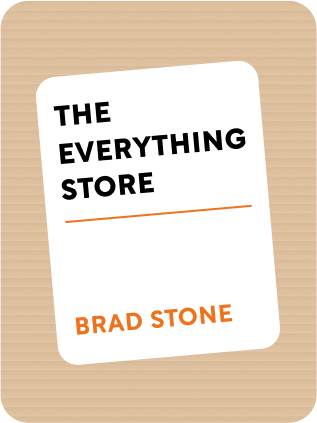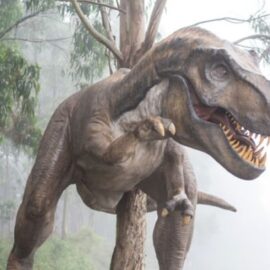

This article is an excerpt from the Shortform book guide to "The Everything Store" by Brad Stone. Shortform has the world's best summaries and analyses of books you should be reading.
Like this article? Sign up for a free trial here .
How was Amazon created? What is Jeff Bezos’ story?
In the book The Everything Store, Amazon’s history is recounted from the beginning. Learn how Jeff Bezos began the internet superstore, the timeline of events that lead to its growth, and what Amazon’s core company values are.
Below is a bulleted overview of The Everything Store by Brad Stone.
How Amazon Came to Be
The Everything Store is Amazon’s story, from its founding by Jeff Bezos as an online bookstore to its rise as a commerce giant. The book also covers a number of Amazon and Bezos’s management techniques.
Timeline of Amazon’s History
- 1994: Bezos notices the Web is growing fast – the number of bytes increased by 2057x fold from the previous year, outpacing other internet technologies at the time, like ftp and gopher.
- At D.E. Shaw, Bezos is tasked with researching opportunities in the Internet.
- They discuss the “everything store” – an intermediary between customers and manufacturers that sells every type of product worldwide, with unlimited shelf space on the Web.
- Bezos leaves D.E. Shaw to start his online bookstore.
- In July 1995, Amazon launches and rides the wave of the internet. Its sales grow exponentially, with $16 million in revenue in 1996 and $148 million in 1997.
- From the beginning, Amazon has customer centricity as its focus. Bezos believes virtuous cycles (lower prices -> more customers -> more leverage on suppliers -> lower prices) will win the day.
- After conquering books, Amazon expands into music, DVDs, toys, and electronics.
- Amazon raises over $1 billion at the height of the dotcom bubble and spends on acquisitions and investments.
- The dotcom bubble crashes. Some analysts predict the death of Amazon, suggesting it will run out of cash within a year. But Amazon is on sounder financial footing than the analysts realize, and Amazon survives.
- The early 2000s sees the rise of Google, which threatens to disintermediate and out-innovate Amazon and make it a relic. Bezos insists on continuous innovation to work their way out of the hole. Over the mid 2000’s, Amazon launches projects like Amazon Prime, Kindle, Amazon Web Services, Mechanical Turk, A9 search engine, Fire tablets. Some projects fail, but others become critical strategic pieces.
- Amazon’s virtuous cycles in retail start really kick off in the mid to late 2000’s. As more of the country relies on Amazon, Amazon in turn exerts pressure on suppliers to lower prices and better terms. It becomes its own media studio, starting a publishing arm and today producing new video content.
- Amazon also gets ruthless with e-commerce competitors like Zappos and Diapers.com. In both situations, Amazon cuts prices on shoes and childcare products (respectively), making the competitors bleed money. Once the companies are weak, Amazon swoops in to acquire them, winning the war.
- Its ruthless competitiveness and willingness to exploit any legal advantage puts it in hot water with regulators and the media. States accuse it of avoiding state sales taxes. It’s frequently portrayed as a bully to pressure better prices. Book publishers collude to set pricing to relieve some of the pricing pressure Amazon places.
- Despite all the controversy, Amazon has only gotten progressively stronger over the past decade. More of the country continues signing up for Prime and using Amazon as their primary retail destination, and Amazon continues its inexorable march to servicing more of our life.
Amazon Company Values
Here’s a brief discussion of the core values that power Amazon. Read the full chapter summary for key examples and quotes about the principle.
Customer Obsession
Bezos is known for his relentless focus on customer satisfaction.
“Leaders start with the customer and work backwards. They work vigorously to earn and keep customer trust. Although leaders pay attention to competitors, they obsess over customers.”
Huge Long-Term Ambitions
Bezos and Amazon are known for thinking huge and having galaxy-sized ambition. They then execute it with dogged determination and boldness.
“Thinking small is a self-fulfilling prophecy. [In contrast,] leaders create and communicate a bold direction that inspires results. They think differently and look around corners for ways to serve customers.”
Breaking Away from Tradition
Even among groundbreaking technology companies, Amazon is lauded for its continuous innovation and breakthrough ideas. Powering this is a constant push to rethink how things are done, never accepting the status quo without further questioning.
“Leaders expect and require innovation and invention from their teams and always find ways to simplify. They are externally aware, look for new ideas from everywhere, and are not limited by ‘not invented here.’ As we do new things, we accept that we may be misunderstood for long periods of time.”
Frugality
Jeff Bezos is famously frugal. Unlike technology companies that dote lavishly on their employees, Amazon is stingy. It believes that in the cutthroat low-margin world of retail, it needs to push for every possible advantage to reduce prices for customers.
“Frugality breeds resourcefulness, self-sufficiency, and invention. There are no extra points for headcount, budget size, or fixed expense.”
Relentless Work Ethic
“You can work long, hard, or smart, but at Amazon you can’t choose two out of three.”
Ability to Dive Deep
Bezos is renowned by his staff for being able to dive into minute details of the business.
“Leaders operate at all levels, stay connected to the details, audit frequently, and are skeptical when metrics and anecdote differ. No task is beneath them.”
Virtuous Cycles
Building virtuous cycles in retail has been a long-running theme in Amazon’s history. Early on, they believed that the larger the company got, the lower the prices it could exact from book distributors, and the more distribution capacity it could afford.
Later in 2001, meeting with Jim Collins, they come up with a renewed virtuous cycle: lower prices leads to more customer visits, leading to more sales, which leads to better returns on fixed costs, which allows further lowering of prices. More customer visits also led to more third-party sellers, which increases selection and thus increases more customers.

———End of Preview———
Like what you just read? Read the rest of the world's best book summary and analysis of Brad Stone's "The Everything Store" at Shortform .
Here's what you'll find in our full The Everything Store summary :
- How Amazon went from an online bookstore to the largest internet retailer in the world
- What Jeff Bezos did to compete with companies like eBay, Zappos, and Diapers.com
- What it was like to work for Jeff Bezos






